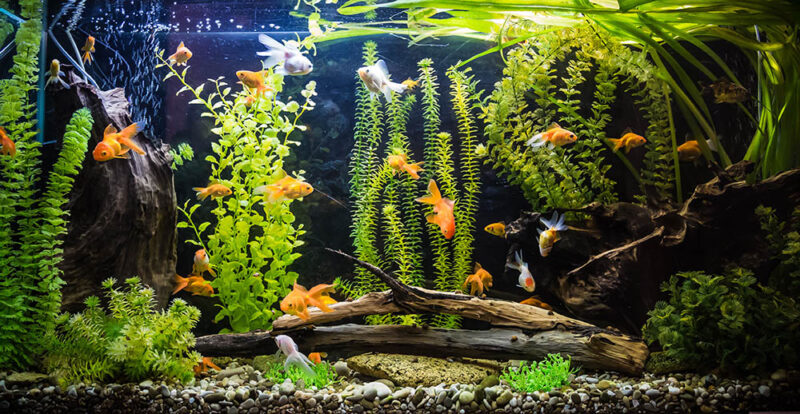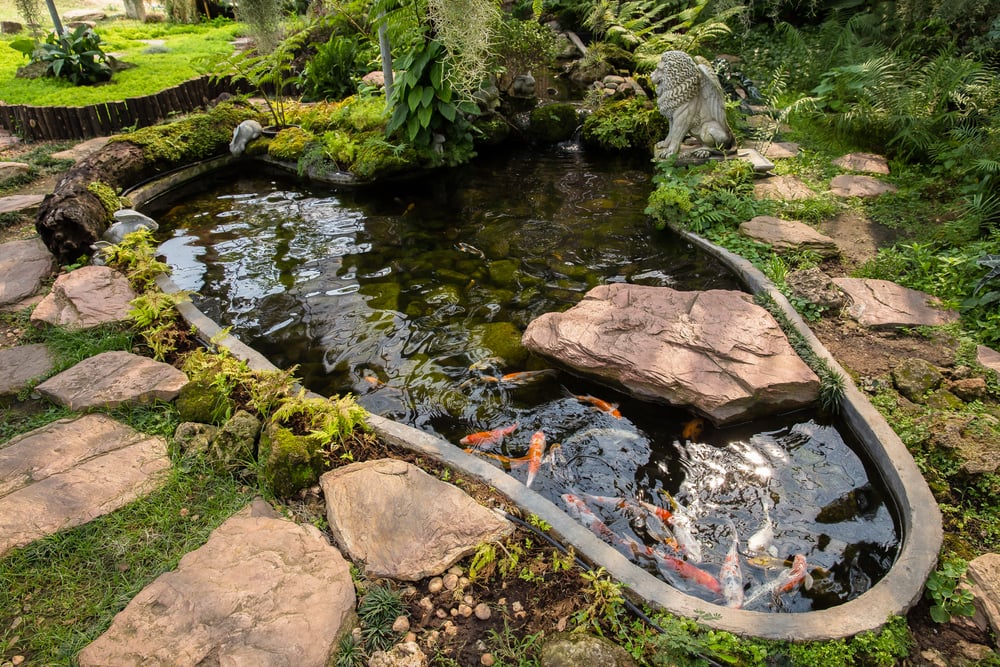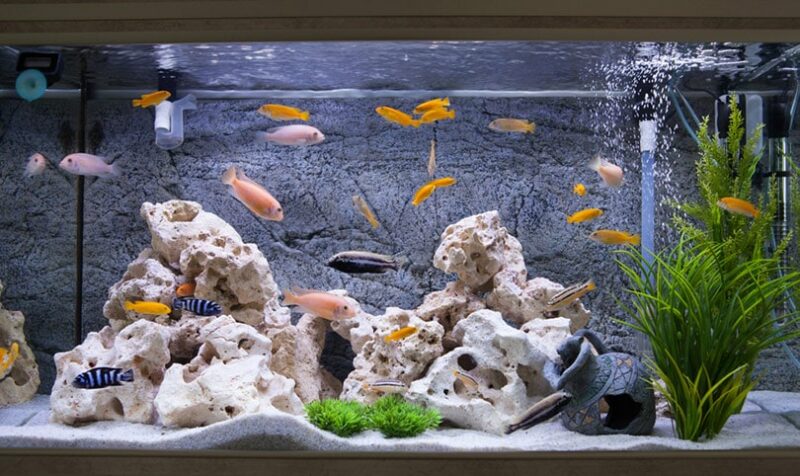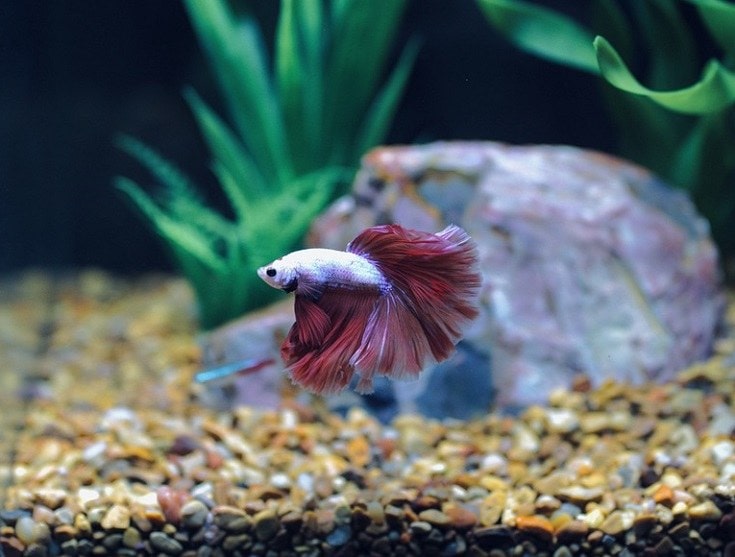Creating an aquarium environment is not just about what fish you put in there anymore. Crafting gorgeous and Insta-worthy aquascape structures is now as much of a hobby as taking care of the fish themselves. If you’re building a low-tech aquarium, without the addition of CO2, you’ll need to make your plant selections more carefully.
To help you out, we’ve put together reviews of what we think are the 10 best low-tech aquarium plants this year. For even more clarity, we’ve also included a buyer’s guide with additional information to factor in as you narrow down your options. Check out our thoughts and enjoy your adventure in underwater gardening!
A Glance at Our Top Picks (2024 Update)
| Image | Product | Details | ||
|---|---|---|---|---|
| Best Overall |

|
Micranthemum Micranthemoides |
|
Check Price |
| Best Value |

|
Dwarf Hairgrass |
|
Check Price |
| Premium Choice |

|
Hygrophilia difformis |
|
Check Price |

|
Anubias barteri |
|
Check Price | |

|
Microsorum Pteropus |
|
Check Price |
The 10 Best Low Tech Aquarium Plants
1. Micranthemum Micranthemoides – Best Overall
| Growth rate: | Moderate |
| Height: | 2-6 inches |
| Light demands | Medium |
| Difficulty: | Easy |
Our pick for the best overall low-tech aquarium plant is Micranthemum Micranthemoides, commonly known as pearlweed. This versatile plant can be trimmed to spread low across the floor of the aquarium. You also have the option to let it grow taller—–up to 6 inches—–for background decor. Pearlweed will grow just fine without Co2 or bright light, although you can manipulate the shape and color if you do choose to add these in. It does need regular trimming, or it will start to grow out of control. Aggressive pruning helps pearlweed form nice dense bushes, ideal for filling empty spaces in an aquascape. Pearlweed offers a good mix of versatility, ease of care, and interesting texture.
2. Dwarf Hairgrass – Best Value
| Growth rate: | Moderate-fas |
| Height: | 1-2 inches |
| Light demands: | Medium-high |
| Difficulty: | Easy |
Our choice of the best low-tech aquarium plant for the money is Dwarf Hairgrass, a popular plant that requires essentially no special care. Dwarf hair grass spreads quickly along the floor of an aquarium, creating a grassy, lawn-like appearance.
While it grows thicker and faster with bright light and CO2, neither is required to keep this plant healthy and spreading. You will need to keep Ddwarf Hairgrass pruned, however, or it will overrun the whole tank. Not only does a healthy crop of Dwarf hair grass look nice in your tank, but it also provides space for shy fish to take cover or a place for spawning.
Housing a goldfish isn't as simple as buying a bowl. If you're a new or experienced goldfish keeper who wants to get the setup right for your goldfish family, check out the best-selling book, The Truth About Goldfish, on Amazon.
It covers all you need to know about the ideal tank setup, tank size, substrate, ornaments, plants, and so much more!
3. Hygrophilia difformis – Premium Choice
| Growth rate: | Fast |
| Max height: | 20 inches |
| Light demands: | Low-medium |
| Difficulty: | Easy |
Commonly known as water wisteria, this plant is actually easier to grow in low-tech tanks because too much CO2 causes it to grow wildly out of control. Water wisteria is a fast-growing, beautifully shaped plant that can be rooted or grow as a floater. It can grow as high as 20 inches, making it an excellent background plant. However, it can also be trimmed and shaped to serve as a lower-level cover.
Water wisteria can grow in lower light conditions. However, because it grows so fast and tall, it may overshade shorter species planted nearby. This plant is sensitive to changes in the aquarium water parameters, so try to keep your tank as stable as possible to help water wisteria thrive.
4. Anubias barteri
| Growth rate: | Slow to moderate |
| Height: | 4-6 inches |
| Light demands: | Low |
| Difficulty: | Easy |
Anubias barteri is a popular choice for low-tech aquascaping because it doesn’t require soil to grow. The rhizomes actually won’t survive if they’re buried and prefer to attach to hard surfaces, like stone or wood. It can grow in shade and, when it’s attached to a portable surface, can be moved around the tank to create variety in the aquascape.
Although Anubias is a hardy plant, its slow growth rate means it has a hard time recovering from damage. It is also prone to algae infestations, especially in brighter light environments. This plant is a good choice for fish tanks that can’t have soil.
5. Microsorum Pteropus
| Growth rate | Slow-moderate |
| Height: | 14 inches |
| Light demands: | Low |
| Difficulty: | Easy |
Microsorum Pteropus, or java fern, is another low-tech plant that prefers to grow above ground. Attach this beautiful plant to rocks, wood, or even aquarium decorations for a pop of color and texture in your aquascape. Java fern tolerates a range of water parameters and grows well in the shade.
As a slow-growth plant, the java fern is in danger of algae infestation and may have trouble adjusting to sudden water changes. It can be propagated easily and tolerates crowded tanks. This plant grows well in a healthy aquarium with minimal intervention, making it a good pick for inexperienced aquascapers.
6. Juncus repens
| Growth rate: | Moderate |
| Height: | 4-12 inches |
| Light demands: | Low |
| Difficulty | Easy |
Juncus repens is easy to grow and resembles long, wavy blades of grass. This plant tolerates a range of temperature conditions and low light. However, if grown in bright light conditions, the usual green leaves of this plant change to red and brown hues. This trait makes Jjuncus repens a good choice if you’re trying to add some color variety to your aquascape.
The height of this plant makes it a mid-level or background species. Because it’s tough and doesn’t have specialized care requirements, this plant is a good pick for beginners. Be aware that it will not tolerate swift changes in water conditions and make any adjustments slowly.
7. Vesicularia Montagne
| Growth rate: | Slow |
| Height: | 1-4 inches |
| Light demands: | Low |
| Difficulty: | Easy |
This low-tech plant, also known as Christmas moss, is easy to grow, hard to kill, and wildly simple to propagate. The moss is slow-growing, but can often be purchased already attached to pieces of wood or rock, making decorating with this plant simple.
To spread Christmas moss, simply prune off some pieces and reattach them in another location. This plant is a popular addition to breeding tanks because it provides a safe environment for fish to lay their eggs. Make sure to provide Christmas moss with an appropriate surface to attach to or it may connect with the tubing of your tank and cause issues. Christmas moss is popular among hardscape tank keepers because it doesn’t need soil and is easily attached to surfaces.
8. Rotala rotundifolia
| Growth rate: | Fast |
| Height: | 2-12 inches |
| Light demands: | High |
| Difficulty: | Easy |
Rotala rotundifolia is another option to consider if you want some alternative color in your aquascape. In the right light, this plant develops a gorgeous bright reddish-orange hue. Rotala is a fast-growing, tall low-tech plant that works best as a background planting and provides cover for fish or invertebrates. The leaves of this plant are quite delicate, so handle them gently. Because of its aggressive growth, this plant does require regular trimming so you can’t just avoid touching the leaves at all. You’ll also need to spend some time removing old growth and replanting new ones. Rotala is easy to grow but does require a bit more maintenance than some other plants on our list.
9. Vallesneria Americana
| Growth rate: | Fast |
| Height: | 12-24 inches |
| Light demands: | Moderate to high |
| Difficulty: | Moderate |
Commonly called jungle val, this low-tech plant will have your aquascape resembling the Amazon in no time as it races to heights up to 24 inches. This plant is best suited for large aquariums because of its height and the amount of soil required to grow it. With long, often twisted leaves, this plant has a gorgeous appearance.
Although it does require a moderate amount of care, jungle val is tolerant of a wide range of water conditions, even brackish water. These plants provide great cover for fish and can be very relaxing to watch as the long leaves ripple in the water.
10. Cryptocoryne Parva
| Growth rate: | Slow |
| Height: | 2-4 inches |
| Light demands: | Low |
| Difficulty: | Easy |
Cryptocoryne Parva is a good low-tech foreground plant because it grows only to a maximum height of 4 inches without needing to be pruned. The long, thin leaves of this plant provide a lush, grass-like appearance.
However, it grows extremely slowly so don’t expect your aqua lawn to be green overnight. Cryptocoryne Parva are easy to care for once they are established but they tend to have a rough time when they’re first planted. The plants take a long time to adjust to new water and may end up melting. They can tolerate low light but grow even more slowly if planted in complete shade.
 Buyer’s Guide: How to Select the Best Low-Tech Aquarium Plants
Buyer’s Guide: How to Select the Best Low-Tech Aquarium Plants
As you can see, there are a lot of low-tech plants available to you, each with unique qualities and its own appeal. To decide which plants are best for you, however, you’ll need to factor in some other considerations.
Can You Have Plants In Your Tank At All?
While planted tanks provide many benefits to fish, including increased oxygen levels, a place to lay eggs, and hiding spots, not all fish are safe to keep with plants. Before going to the trouble of planting and maintaining your aquascape, make sure your fish aren’t going to eat it or destroy it. Fish species to avoid include plecos and silver dollar fish, who’ll make a meal out of your whole planting. Also, avoid species like oscars and cichlids who like to burrow in the substrate and can destroy the plant’s roots.
Size Matters
If you want to create a balanced low-tech aquascape, you’ll need to consider the heights of all the plants and plan their locations carefully. Not only do you want your tank to look nice, but you also need to make sure no plants grow too tall and impact the light for others. As you plan your plantings, remember that some species grow just fine in lower light or even shade.
Match Requirements Carefully
For best results, you’ll want to choose plants that match the light and water parameters of your tank. If you’re starting from scratch then you can plan based on your ultimate goal for the aquascape. However, if you’re adding plants to an established tank, you’ll need to make sure they can tolerate the water conditions already in place for the fish. Choose plants with similar light requirements or those whose conditions complement each other.

Do You Want Color?
Most of the low-tech plants on our list and in the aquarium world come in shades of green. If you want to provide some color contrast, your options are more limited. This is especially true if the development of the red color requires special lighting or water conditions.
Conclusion
As the best overall low-tech aquarium plant, Micranthemum Micranthemoides offers versatility in height and usage, combined with a beautiful appearance. Our best low-tech aquarium plant for the money, Dwarf Hairgrass, is fast-growing and easy to care for, offering a lush look with minimal commitment. Building a planted tank can be complicated and time-consuming but we hope our reviews of these 10 low-tech aquarium plants gives you an idea of where to begin.
Featured Image Credit: Amuljar, Pixabay







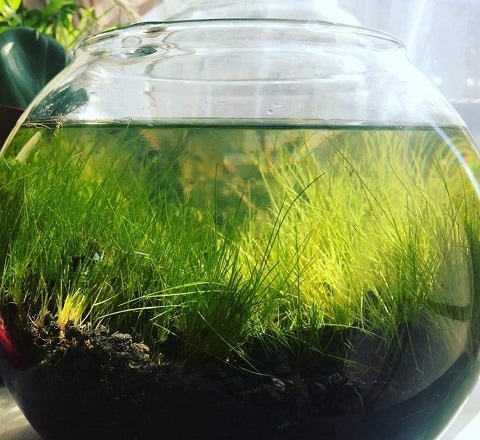










 Buyer’s Guide: How to Select the Best Low-Tech Aquarium Plants
Buyer’s Guide: How to Select the Best Low-Tech Aquarium Plants